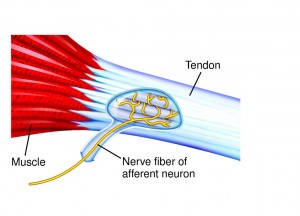Proprioception & Mechano-Receptors
This gymnast knows exactly where each body part is, and what motion it is undergoing.
The simple act of walking upright is actually not so simple; it is still a challenge for robot designers. When our body’s ability to sense its position and orientation – known as proprioception – becomes impaired, our ability to move quickly and accurately degrades and our athletic performance suffers. That degradation of performance leads to injury. One facet of proprioception is the product of our muscles’ tension receptors, dysfunction of which can also cause chronic pain. Knowing how to locate and heal tension receptors using chiropractic care can quickly reverse years of chronic pain where other attempts to heal brought only temporary relief.
If the muscles become scarred and fibrous, tension receptors in the muscle belly do not readily change shape with the muscle, resulting in delayed or absent responses. When this happens, the brain fails to register the degree of muscle contraction. Consequently, the brain’s signal to contract is increased, causing spasms and/or continuous muscle tension.
When a muscle is either tense or constantly tight it may have fibrous, stiff, and frozen tension receptors. Even when the patient believes they are relaxed, the muscles are tight. It is tight when they go to sleep and tight when they wake up. Appropriate chiropractic adjustments can change the tension receptors and the muscle will relax temporarily, but constant tightness will return shortly because the tension receptor has not changed. With correct treatment plans, the benefit can become permanent. This is why a person often needs to return to see the chiropractor a few times for follow-up exams and treatments.

The nerve fiber leads from the GTO to the spine. The GTO measures muscle tension. If it is not working correctly, the brain won’t be able to balance the muscle.



